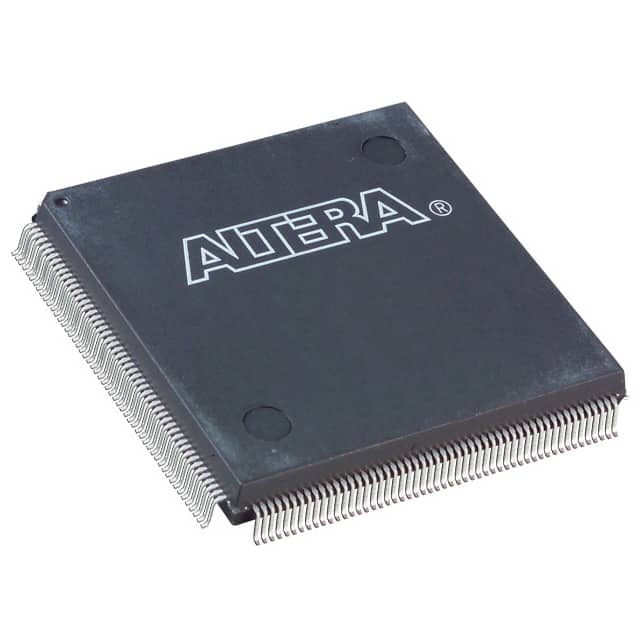EP1K30QC208-1N
Product Overview
Category: Integrated Circuit (IC)
Use: The EP1K30QC208-1N is a programmable logic device (PLD) that belongs to the family of field-programmable gate arrays (FPGAs). It is designed for digital logic applications and offers high flexibility and reconfigurability.
Characteristics: - High-performance FPGA - Programmable logic elements - Embedded memory blocks - Flexible I/O interfaces - Low power consumption
Package: The EP1K30QC208-1N is available in a Quad Flat Package (QFP) with 208 pins. This package provides easy integration into circuit boards and ensures reliable electrical connections.
Essence: The essence of EP1K30QC208-1N lies in its ability to be programmed and reprogrammed to perform various digital logic functions, making it suitable for a wide range of applications.
Packaging/Quantity: The EP1K30QC208-1N is typically sold individually in anti-static packaging to prevent damage during transportation and storage.
Specifications
- Logic Cells: 1,280
- Maximum Frequency: 200 MHz
- Operating Voltage: 3.3V
- Operating Temperature Range: -40°C to 85°C
- Programmable I/O Pins: 173
- Embedded Memory: 36,864 bits
- Total RAM Bits: 72,704
- Total User Flash Memory: 1,152 Kbits
Pin Configuration
The EP1K30QC208-1N has a total of 208 pins arranged in a specific configuration. The detailed pinout can be found in the product datasheet.
Functional Features
- High-speed data processing capabilities
- Configurable logic elements for custom digital circuit design
- On-chip memory blocks for efficient data storage
- Flexible I/O interfaces for seamless integration with external devices
- Support for various communication protocols
Advantages and Disadvantages
Advantages: - Flexibility: The EP1K30QC208-1N can be reprogrammed to adapt to changing requirements, eliminating the need for hardware changes. - High Performance: With a maximum frequency of 200 MHz, it offers fast and efficient data processing capabilities. - Cost-effective: By using a single device for multiple applications, it reduces the overall cost of system development.
Disadvantages: - Complexity: Programming and configuring the EP1K30QC208-1N requires expertise in digital logic design and FPGA programming. - Limited Resources: Compared to dedicated ASICs, FPGAs have limited resources and may not be suitable for extremely complex designs.
Working Principles
The EP1K30QC208-1N works based on the principle of reconfigurable logic. It consists of programmable logic elements, memory blocks, and I/O interfaces. The device can be programmed using hardware description languages (HDL) or graphical tools to define the desired digital logic functions. Once programmed, the EP1K30QC208-1N executes these functions by routing signals through its configurable logic elements and utilizing the embedded memory blocks for data storage.
Detailed Application Field Plans
The EP1K30QC208-1N finds applications in various fields, including:
- Telecommunications: Used in network routers, switches, and base stations for high-speed data processing and protocol handling.
- Industrial Automation: Employed in control systems, PLCs, and robotics for real-time control and monitoring.
- Automotive Electronics: Integrated into automotive systems for engine control, driver assistance, and infotainment.
- Medical Devices: Utilized in medical imaging equipment, patient monitoring systems, and laboratory instruments for data processing and analysis.
- Aerospace and Defense: Incorporated in avionics, radar systems, and military communication devices for reliable and secure data processing.
Detailed and Complete Alternative Models
- EP2K30QC208-1N: A higher-capacity FPGA with 2,560 logic cells and increased memory resources.
- EP1K50QC208-1N: A similar FPGA with 50% more logic cells and enhanced I/O capabilities.
- EP1K10TC144-1N: A lower-cost alternative with reduced logic capacity but suitable for less complex applications.
These alternative models provide options with varying capacities and features to cater to different project requirements.
Word count: 529 words
기술 솔루션에 EP1K30QC208-1N 적용과 관련된 10가지 일반적인 질문과 답변을 나열하세요.
Sure! Here are 10 common questions and answers related to the application of EP1K30QC208-1N in technical solutions:
Q1: What is EP1K30QC208-1N? A1: EP1K30QC208-1N is a specific model of Field Programmable Gate Array (FPGA) manufactured by Intel. It offers 1,152 logic elements and 30,000 usable gates.
Q2: What are the typical applications of EP1K30QC208-1N? A2: EP1K30QC208-1N can be used in various technical solutions such as digital signal processing, industrial automation, robotics, telecommunications, and embedded systems.
Q3: How does EP1K30QC208-1N benefit digital signal processing applications? A3: EP1K30QC208-1N provides high-speed processing capabilities, parallel computing, and flexibility for implementing complex algorithms, making it suitable for digital signal processing tasks like image and audio processing.
Q4: Can EP1K30QC208-1N be used in industrial automation? A4: Yes, EP1K30QC208-1N can be utilized in industrial automation systems for tasks like control and monitoring, data acquisition, and communication interfaces due to its ability to handle real-time operations and interface with various sensors and actuators.
Q5: Is EP1K30QC208-1N suitable for robotics applications? A5: Absolutely! EP1K30QC208-1N can be employed in robotics for tasks like motor control, sensor integration, motion planning, and decision-making algorithms, enabling efficient and precise robotic operations.
Q6: How does EP1K30QC208-1N contribute to telecommunications solutions? A6: EP1K30QC208-1N can be used in telecommunications applications for tasks like data compression, encryption, error correction, and protocol handling, providing high-speed processing and efficient data manipulation.
Q7: Can EP1K30QC208-1N be used in embedded systems? A7: Yes, EP1K30QC208-1N is suitable for embedded systems due to its compact size, low power consumption, and ability to integrate multiple functions on a single chip, making it ideal for applications like IoT devices, automotive electronics, and consumer electronics.
Q8: What programming languages can be used with EP1K30QC208-1N? A8: EP1K30QC208-1N can be programmed using Hardware Description Languages (HDLs) such as VHDL or Verilog. Additionally, Intel provides development tools like Quartus Prime that support these languages.
Q9: Are there any limitations to consider when using EP1K30QC208-1N? A9: EP1K30QC208-1N has limited resources compared to higher-end FPGAs, so complex designs may require more advanced models. It's important to carefully analyze the design requirements and ensure they fit within the device's capabilities.
Q10: Where can I find additional resources and support for EP1K30QC208-1N? A10: Intel provides documentation, application notes, reference designs, and technical support for EP1K30QC208-1N on their official website. Additionally, online forums and communities dedicated to FPGA development can be valuable sources of information and assistance.


